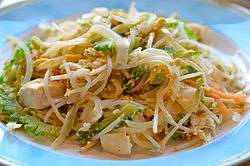Chanpuru
|
Goya chanpuru | |
| Alternative names | チャンプルー |
|---|---|
| Type | Stir fry |
| Place of origin | Japan |
| Region or state | Okinawa |
| Main ingredients | Tofu, vegetables |
|
| |
Chanpuru (Okinawan: チャンプルー Chanpuruu) is an Okinawan stir fry dish. It is considered the representative dish of Okinawan cuisine.[1][2] Chanpuru generally consists of tofu combined with some kind of vegetable, meat, or fish.[2] Luncheon meat (such as Spam or Danish Tulip), egg, moyashi (bean sprouts) and goya (bitter melon) are some other common ingredients. Spam is not typically used in mainland Japan; but it is more common in Okinawa due primarily to the historical influence of its introduction by the US Navy. Chanpuru is Okinawan for "something mixed" and the word is sometimes used to refer to the culture of Okinawa, as it can be seen as a mixture of traditional Ryūkyū, Chinese, Japanese, Southeast Asian and North American culture. The term originates from the Malay or Indonesian word campur (pronounced "cham-poor"), meaning "mix".[3]
Long a local specialty only found on Okinawa, chanpuru has in recent years, through television shows and increased interest in Okinawan culture, spread to many restaurants on mainland Japan.
Types of chanpuru
Goya chanpuru
Goya chanpuru is the quintessential chanpuru. It consists of goya (bitter melon), egg, tōfu, and either Spam or thinly sliced pork.[2][4] It often also includes vegetables such as carrots.
Tōfu chanpuru
Tōfu chanpuru is tofu stir-fried with vegetables and Spam, bacon, thinly sliced pork belly, or canned tuna. Unlike tofu from mainland Japan, Okinawan tofu is firm and does not fall apart when stir-fried.[2] It is considered best form to crumble the tofu into the frying pan by hand, so as to avoid uniform cubes.
Māmina chanpuru
Māmina chanpuru is version of chanpuru that contains moyashi, or mung bean sprouts.[1][2]
Fu chanpuru
Fu is a kind of flatbread made from wheat bran, water, and eggs. It is stir-fried with vegetables and a meat as above.
Sōmen chanpuru
Sōmen (or somin in Okinawan) are very thin noodles resembling angel hair pasta. They are stir-fried lightly in oil with green onions and meat as above.
Cultural aspects
Chanpuru (sometimes written and pronounced champloo) is Okinawan for "something mixed" and Okinawans take great pride in describing their culture and traditional attitudes to people and food as chanpuru. They will cite examples of their happy acceptance of foreign cultural items in the popularity of awamori (originally a liquor from Thailand), tacos albeit with added rice (from Mexico) and rafute (a Chinese meat dish).
See also
References
- 1 2 "ちゃんぷるー" [Chanpuru]. Dijitaru Daijisen (in Japanese). Tokyo: Shogakukan. 2012. OCLC 56431036. Retrieved 2012-12-17.
- 1 2 3 4 5 "ちゃんぷるー" [Chanpuru]. Nihon Daihyakka Zensho (Nipponika) (in Japanese). Tokyo: Shogakukan. 2012. OCLC 153301537. Retrieved 2012-12-17.
- ↑ 岸 朝子(きし・あさこ). "Chanpuru shokubunka" (in Japanese). doraku.asahi.com. Retrieved 2011-11-03.
- ↑ "Goya Chanpuru". About.com Japanese Food. Retrieved September 7, 2011.
| Wikimedia Commons has media related to Chanpuru. |
